Potentially Toxic Elements in Ultramafic Soils: A Study from Metamorphic Ophiolites of the Voltri Massif (Western Alps, Italy)
Abstract
1. Introduction
2. Geological Setting
3. Materials and Methods
4. Results
4.1. Soil Profiles
4.2. Soil Micromorphology
4.3. Soil Mineralogy
4.4. Bulk Chemistry
4.5. PTEs Distribution in Primary and Authigenic Minerals
5. Discussion
General Environmental Implications
6. Conclusions
Supplementary Materials
Author Contributions
Funding
Acknowledgments
Conflicts of Interest
References
- Oze, C.; Fendorf, S.; Bird, D.K.; Coleman, R.G. Chromium geochemistry in serpentinized ultramafic rocks and serpentine soils from the Franciscan complex of California. Am. J. Sci. 2004, 304, 67–101. [Google Scholar] [CrossRef]
- Oze, C.; Fendorf, S.; Bird, D.K.; Coleman, R.G. Chromium geochemistry of serpentine soils. Int. Geol. Rev. 2004, 46, 97–126. [Google Scholar] [CrossRef]
- Burt, R.; Wilson, M.A. Serpentinitic Soils. In Encyclopedia of Soil Science, 2nd ed.; Rattan, L., Ed.; Taylor & Francis: Abingdon, UK, 2006; pp. 1564–1567. [Google Scholar]
- Rajapaksha, A.U.; Vithanage, M.; Oze, C.; Bandara, W.M.A.T.; Weerasooriya, R. Nickel and manganese release in serpentine soil from the Ussangoda Ultramafic Complex, Sri Lanka. Geoderma 2012, 189–190, 1–9. [Google Scholar] [CrossRef]
- Kelepertzis, E.; Galanos, E.; Mitsis, I. Origin, mineral speciation and geochemical baseline mapping of Ni and Cr in agricultural topsoils of Thiva valley (central Greece). J. Geochem. Explor. 2013, 125, 56–68. [Google Scholar] [CrossRef]
- Rajapaksha, A.; Vithanage, M.; Ok, Y.S.; Oze, C. Cr(VI) formation related to Cr(III)-muscovite and birnessite interactions in ultramafic environments. Environ. Sci. Technol. 2013, 47, 9722–9729. [Google Scholar] [CrossRef]
- Kumarathilaka, P.; Dissanayake, C.; Vithanage, M. Geochemistry of serpentinite soils: A brief overview. J. Geol. Soc. Sri Lanka 2014, 16, 53–63. [Google Scholar]
- Vithanage, M.; Rajapaksha, A.U.; Oze, C.; Rajakaruna, N.; Dissanayake, C.B. Metal release from serpentine soils in Sri Lanka. Environ. Monit. Assess. 2014, 186, 3415–3429. [Google Scholar] [CrossRef] [PubMed]
- Baumeister, J.L.; Hausrath, E.M.; Olsen, A.A.; Tschauner, O.; Adcock, C.T.; Metcalf, R.V. Biogeochemical weathering of serpentinites: An examination of incipient dissolution affecting serpentine soil formation. Appl. Geochem. 2015, 54, 74–84. [Google Scholar] [CrossRef]
- Caillaud, J.; Proust, D.; Philippe, S.; Fontaine, C.; Fialin, M. Trace metals distribution from a serpentinite weathering at the scales of the weathering profile and its related weathering microsystems and clay minerals. Geoderma 2009, 149, 199–208. [Google Scholar] [CrossRef]
- Tashakor, M.; Yaacob, W.Z.W.; Mohamad, H.; Ghani, A.A. Geochemical characteristics of serpentinite soils from Malaysia. Malays. J. Soil Sci. 2014, 18, 35–49. [Google Scholar]
- Kabata-Pendias, A.; Mukherjee, A.B. Trace Elements from Soil to Human; Springer-Verlag: Berlin, Germany, 2007; 550p. [Google Scholar]
- Kabata-Pendias, A. Trace Elements in Soils and Plants, 4th ed.; CRC Press Taylor & Francis Group: Boca Raton, FL, USA, 2011; 505p. [Google Scholar]
- Alexander, E.B.; Coleman, R.G.; Keeler-Wolf, T.; Harrison, S. Serpentine Geoecology of Western North America: Geology, Soils, and Vegetation; Oxford University Press, Inc.: New York, NY, USA, 2007; 512p. [Google Scholar]
- Echevarria, G. Genesis and behaviour of ultramafic soils and consequences for nickel biogeochemistry. In Agromining: Farming for Metals. Extracting Unconventional Resources Using Plants; van der Ent, A., Echevarria, G., Baker, A.J.M., Morel, J.L., Eds.; Springer International Publishing: Chan, Switzerland, 2018; pp. 135–156. [Google Scholar]
- Cortesogno, L.; Mazzucotelli, A.; Vannucci, R. Alcuni esempi di pedogenesi su rocce ultrafemiche in clima mediterraneo. Ofioliti 1979, 4, 295–312. (In Italian) [Google Scholar]
- Legros, J.P. Soils of alpine mountains. In Weathering, Soils and Paleosoils: Developments in Earth Surface Processes, 2nd ed.; Martini, I.P., Chesworth, W., Eds.; Elsevier: Amsterdam, The Netherlands, 1992; pp. 55–181. [Google Scholar]
- Morrison, J.M.; Goldhaber, M.B.; Lee, L.; Holloway, J.M.; Wanty, R.B.; Wolf, R.E.; Ranville, J.F. A regional-scale study of chromium and nickel in soils of northern California, USA. Appl. Geochem. 2009, 24, 1500–1511. [Google Scholar] [CrossRef]
- Foth, H.D. Fundamentals of Soil Science, 8th ed.; John Wiley & Sons, Inc.: New York, NY, USA, 1991; 272p. [Google Scholar]
- Alexander, E.B. Morphology, fertility and classification of productive soils on serpentinised peridotite in California, U.S.A. Geoderma 1988, 41, 337–351. [Google Scholar] [CrossRef]
- Lee, B.D.; Sears, S.K.; Graham, R.C.; Amrhein, C.; Vali, H. Secondary mineral genesis from chlorite and serpentine in an ultramafic soil toposequence. Soil Sci. Soc. Am. J. 2003, 67, 1309–1317. [Google Scholar] [CrossRef]
- Alexander, E.B. Serpentine soil redness, differences among peridotite and serpentinite materials, Klamath Mountains, California. Int. Geol. Rev. 2004, 46, 754–764. [Google Scholar] [CrossRef]
- Chardot, V.; Echevarria, G.; Gury, M.; Massoura, S.; Morel, J.L. Nickel bioavailability in an ultramafic toposequence in the Vosges Mountains (France). Plant Soil 2007, 293, 7–21. [Google Scholar] [CrossRef]
- Hseu, Z.Y.; Tsai, H.; Hsi, H.C.; Chen, Y.C. Weathering sequences of clay minerals in soils along a serpentinitic toposequence. Clays Clay Miner. 2007, 55, 389–401. [Google Scholar] [CrossRef]
- Alexander, E.B. Soil and vegetation differences from peridotite to serpentinite. Northeast. Nat. 2009, 16, 178–192. [Google Scholar] [CrossRef]
- Caillaud, J.; Proust, D.; Righi, D.; Martin, F. Fe-rich clays in a weathering profile developed from serpentinite. Clays Clay Miner. 2004, 52, 779–791. [Google Scholar] [CrossRef]
- Alexander, E.B.; DuShey, J. Topographic and soil differences from peridotite to serpentinite. Geomorphology 2011, 135, 271–276. [Google Scholar] [CrossRef]
- Kierczak, J.; Pędziwiatr, A.; Waroszewski, J.; Modelska, M. Mobility of Ni, Cr and Co in serpentine soils derived on various ultrabasic bedrocks under temperate climate. Geoderma 2016, 268, 78–91. [Google Scholar] [CrossRef]
- Pędziwiatr, A.; Kierczak, J.; Waroszewski, J.; Ratié, G.; Quantin, C.; Ponzevera, E. Rock-type control of Ni, Cr, and Co phytoavailability in ultramafic soils. Plant Soil 2018, 423, 339–362. [Google Scholar] [CrossRef]
- Capponi, G.; Crispini, L. Note Illustrative della Carta Geologica d’Italia alla scala 1: 50.000 Foglio 213-230, Genova; APAT, Agenzia per la Protezione dell’Ambiente e per i Servizi Tecnici: Roma, Italy, 2008; 139p. [Google Scholar]
- Cimmino, F.; Messiga, B.; Piccardo, G.B. Ti-clinohumite-bearing assemblages within antigoritic serpentinites of the Voltri Massif (Western Liguria): Inferences on the geodynamic evolution of piemontese ultramafic sections. Ofioliti 1979, 4, 97–120. [Google Scholar]
- Messiga, B.; Scambelluri, M. Retrograde P-T-t path for the Voltri Massif eclogites (Ligurian Alps, Italy): Some tectonic implications. J. Metamorph. Geol. 1991, 9, 93–109. [Google Scholar] [CrossRef]
- Scambelluri, M.; Müntener, O.; Hermann, J.; Piccardo, G.B.; Trommsdorff, V. Subduction of water into the mantle: History of an Alpine peridotite. Geology 1995, 23, 459–462. [Google Scholar] [CrossRef]
- Federico, L.; Capponi, G.; Crispini, L.; Scambelluri, M.; Villa, I.M. 39Ar/40Ar dating of high-pressure rocks from the Ligurian Alps: Evidence for a continuous subduction–exhumation cycle. Earth Planet Sc. Lett. 2005, 240, 668–680. [Google Scholar] [CrossRef]
- Malatesta, C.; Federico, L.; Crispini, L.; Capponi, G. Fluid-controlled deformation in blueschist-facies conditions: plastic vs brittle behaviour in a brecciated mylonite (Voltri Massif, Western Alps, Italy). Geol. Mag. 2018, 155, 335–355. [Google Scholar] [CrossRef]
- Malatesta, C.; Crispini, L.; Federico, L.; Capponi, G.; Scambelluri, M. The exhumation of high-pressure ophiolites (Voltri Massif, Western Alps): Insights from structural and petrologic data on metagabbro bodies. Tectonophysics 2012, 568, 102–123. [Google Scholar] [CrossRef]
- Capponi, G.; Crispini, L.; Federico, L.; Malatesta, C. Geology of the Eastern Ligurian Alps: A review of the tectonic units. Ital. J. Geosci. 2016, 135, 157–169. [Google Scholar] [CrossRef]
- Rampone, E.; Romairone, A.; Abouchami, W.; Piccardo, G.B.; Hofmann, A.W. Chronology, petrology and isotope geochemistry of the Erro–Tobbio peridotites (Ligurian Alps, Italy): Records of Late Palaeozoic lithospheric extension. J. Petrol. 2005, 46, 799–827. [Google Scholar] [CrossRef]
- Scambelluri, M.; Hoogerduijn Strating, E.H.; Piccardo, G.B.; Vissers, R.L.M.; Rampone, E. Alpine olivine- and titanian clinohumite-bearing assemblages in the Erro–Tobbio peridotite (Voltri Massif, NW Italy). J. Metamorph. Geol. 1991, 9, 79–91. [Google Scholar] [CrossRef]
- Hermann, J.; Muntener, O.; Scambelluri, M. The importance of serpentinite milonite for subduction and exhumation of oceanic crust. Tectonophysics 2000, 327, 225–238. [Google Scholar] [CrossRef]
- Crispini, L.; Capponi, G. Tectonic evolution of the Voltri Group and Sestri Voltaggio Zone (southern limit of the NW Alps): A review. Ofioliti 2001, 26, 161–164. [Google Scholar]
- Capponi, G.; Crispini, L. Structural and metamorphic signature of alpine tectonics in the Voltri Massif (Ligurian Alps, North-Western Italy). Eclogae Geol. Helv. 2002, 95, 31–42. [Google Scholar]
- Federico, L.; Crispini, L.; Scambelluri, M.; Capponi, G. Different PT paths recorded in a tectonic mélange (Voltri Massif, NW Italy): Implications for the exhumation of HP rocks. Geodin. Acta 2007, 20, 3–19. [Google Scholar] [CrossRef]
- Messiga, B.; Piccardo, G.B.; Ernst, W.G. High-pressure eo-Alpine parageneses developed in magnesian metagabbros, Gruppo di Voltri, western Liguria, Italy. Contrib. Mineral. Petr. 1983, 83, 1–15. [Google Scholar] [CrossRef]
- Spandler, C.; Hermann, J.; Faure, K.; Mavrogenes, J.A.; Arculus, R.J. The importance of talc and chlorite “hybrid” rocks for volatile recycling through subduction zones; evidence from the high-pressure subduction mélange of New Caledonia. Contrib. Mineral. Petr. 2008, 155, 181–198. [Google Scholar] [CrossRef]
- Bonifacio, E.; Zanini, E.; Boero, V.; Franchini-Angela, M. Pedogenesis in a soil catena on serpentinite in north-western Italy. Geoderma 1997, 75, 33–51. [Google Scholar] [CrossRef]
- Marsili, S.; Roccotiello, E.; Rellini, I.; Giordani, P.; Barberis, G.; Mariotti, M.G. Ecological studies on the serpentine endemic plant Cerastium utriense Barberis. Northeast. Nat. 2009, 16, 405–421. [Google Scholar] [CrossRef]
- Scopesi, C.; Maerker, M.; Bachofer, F.; Rellini, I.; Firpo, M. Assessment of flash floods in a small Mediterranean catchment using terrain analysis and remotely sensed data: A case study in the Torrente Teiro, Liguria, Italy. Z. Geomorphol. 2017, 61, 137–163. [Google Scholar] [CrossRef]
- Geoportale Regione Liguria. Available online: https://geoportal.regione.liguria.it (accessed on 15 May 2019).
- Capponi, G.; Crispini, L.; Federico, L.; Cabella, R.; Faccini, F.; Ferraris, F.; Firpo, M.; Marescotti, P.; Piazza, M.; Roccati, A.; et al. Note illustrative al Foglio 212 ‘Spigno Monferrato’ della Carta Geologica Regionale della Liguria; Regione Liguria, Dipartimento Ambiente: Genova, Italy, 2013; 144p. [Google Scholar]
- Albanese, S.; Sadeghi, M.; Lima, A.; Cicchella, D.; Dinelli, E.; Valera, P.; Falconi, M.; Demetriades, A.; De Vivo, B.; GEMAS Project Team. GEMAS: Cobalt, Cr, Cu and Ni distribution in agricultural and grazing land soil of Europe. J. Geochem. Explor. 2015, 154, 81–93. [Google Scholar] [CrossRef]
- IUSS Working Group WRB. World Reference Base for Soil Resources 2014, Update 2015. International Soil Classification System for Naming Soils and Creating Legends for Soil Maps; World Soil Resources Reports No. 106; IUSS Working Group WRB: Rome, Italy, 2015. [Google Scholar]
- Munsell® Soil Color Charts; Revisised Edition; Munsell Color Company; Kollmorgen Corp.; Macbeth Division: New York, NY, USA, 2000.
- Folk, R.L. The distinction between grain size and mineral composition in sedimentary-rock nomenclature. J. Geol. 1954, 62, 344–359. [Google Scholar] [CrossRef]
- Schlee, J.S. Atlantic Continental Shelf and Slope of the United States—Sediment Texture of the Northeastern Part; Geological Survey Professional Paper 529-L; U.S. Department of the Interior: Washington, DC, USA, 1973; 64p.
- Delvigne, J. Atlas of Micromorphology of Mineral Alteration and Weathering; The Canadian Mineralogy Spec. Publ. 3; Mineralogical Association of Canada: Ottawa, ON, Canada, 1998; 494p. [Google Scholar]
- Stoops, G.; Marcelino, V.; Mees, F. (Eds.) Interpretation of Micromorphological Features of Soils and Regoliths; Elsevier: Amsterdam, The Netherlands, 2010; 720p. [Google Scholar]
- Rebuffi, L.; Plaisier, J.R.; Abdellatief, M.; Lausi, A.; Scardi, P. MCX: A synchrotron radiation beamline for X-ray diffraction line profile analysis. Z. Anorg. Allg. Chem. 2014, 640, 3100–3106. [Google Scholar] [CrossRef]
- Larson, A.C.; Von Dreele, R.B. GSAS. Report No. LAUR 86-748. J. Appl. Crystallogr. 2001, 34, 210–213. [Google Scholar]
- Zucchini, A.; Comodi, P.; Katerinopoulou, A.; Balic-Zunic, T.; McCammon, C.; Frondini, F. Order-disorder-reorder process in thermally treated dolomite samples: A combined powder and single-crystal X-ray diffraction study. Phys. Chem. Miner. 2012, 39, 219–328. [Google Scholar] [CrossRef]
- Frondini, F.; Zucchini, A.; Comodi, P. Water-rock interactions and trace elements distribution in dolomite aquifers: The Sassolungo and Sella systems (Northern Italy). Geochem, J. 2014, 48, 231–246. [Google Scholar] [CrossRef]
- Gentili, S.; Comodi, P.; Nazzareni, S.; Zucchini, A. The Orvieto-Bagnoregio Ignimbrite: Pyroxene crystal-chemistry and bulk phase composition of pyroclastic deposits, a tool to identify syn- and post-depositional processes. Eur. J. Mineral. 2014, 26, 743–775. [Google Scholar] [CrossRef]
- Lafuente, B.; Downs, R.T.; Yang, H.; Stone, N. The power of databases: the RRUFF project. In Highlights in Mineralogical Crystallography; Armbruster, T., Danisi, R.M., Eds.; de Gruyter GmbH & Co.: Berlin, Germany, 2015; pp. 1–30. [Google Scholar]
- Hill, R.J.; Howard, C.J. Quantitative phase analysis from neutron powder diffraction data using the Rietveld method. J. Appl. Cryst. 1987, 20, 467–474. [Google Scholar] [CrossRef]
- Konta, J. Theoretical Argillology for the Application of Sealing, Sorbent and Catalytic Clays; Servizio Publicazioni del Gruppo Italiano dell’AIPEA: Faenza, Italy, 2001; 152p. [Google Scholar]
- Petrelli, M.; Morgavi, D.; Vetere, F.; Perugini, D. Elemental imaging and petro-volcanological applications of an improved laser ablation inductively coupled quadrupole plasma mass spectrometry. Period. Mineral. 2016, 85, 25–39. [Google Scholar]
- Kretz, R. Symbols of rock-forming minerals. Am. Mineral. 1983, 68, 277–279. [Google Scholar]
- Zanazzi, P.F.; Comodi, P.; Nazzareni, S.; Andreozzi, G.B. Thermal behaviour of chlorite: An in situ single-crystal and powder diffraction study. Eur. J. Mineral. 2009, 21, 581–589. [Google Scholar] [CrossRef]
- Fornasaro, S.; Comodi, P.; Crispini, C.; Malatesta, C.; Zucchini, A.; Marescotti, P. Potentially toxic elements distribution in the serpentinized and deformed ultramafic rocks from the Voltri Massif (NW, Italy). Period. Mineral. 2019, 88. [Google Scholar] [CrossRef]
- Bani, A.; Echevarria, G.; Zhang, X.; Benizri, E.; Laubie, B.; Morel, J.L.; Simonnot, M.O. The effect of plant density in nickel-phytomining field experiments with Alyssum murale in Albania. Aust. J. Bot. 2015, 63, 72–77. [Google Scholar] [CrossRef]
- Angelone, M.; Vaselli, O.; Bini, C.; Coradossi, N. Pedogeochemical evolution and trace elements availability to plants in ophiolitic soils. Sci. Total Environ. 1993, 129, 291–309. [Google Scholar] [CrossRef]
- Venturelli, G.; Contini, S.; Bonazzi, A.; Mangia, A. Weathering of ultramafic rocks and element mobility at Mt. Prinzera, Northern Apennines, Italy. Mineral. Mag. 1997, 61, 765–778. [Google Scholar] [CrossRef]
- D’Amico, M.; Julitta, F.; Previtali, F.; Cantelli, D. Podzolization over ophiolitic materials in the western Alps (Natural Park of Mont Avic, Aosta Valley, Italy). Geoderma 2008, 146, 129–137. [Google Scholar] [CrossRef]
- Quantin, C.; Ettler, V.; Garnier, J.; Sebek, O. Sources and extractibility of chromium and nickel in soil profiles developed on Czech serpentinites. C. R. Geosci. 2008, 340, 872–882. [Google Scholar] [CrossRef]
- Alves, S.; Trancoso, M.A.; de Lurdes Simões Gonncalves, M.; Correia dos Santos, M.M. A nickel availability study in serpentinised area of Portugal. Geoderma 2001, 164, 155–163. [Google Scholar] [CrossRef]
- Cheng, C.H.; Jien, S.H.; Iizuka, Y.; Tsai, H.; Chang, Y.H.; Hseu, Z.Y. Pedogenic chromium and nickel partitioning in serpentine soils along a toposequence. Soil Sci. Soc. Am. J. 2011, 75, 659–668. [Google Scholar] [CrossRef]
- Bani, A.; Echevarria, G.; Montarges-Pelletier, E.; Gjoka, F.; Sulce, S.; Morel, J.L. Pedogenesis and nickel biogeochemistry in a typical Albanian ultramafic toposequence. Environ. Monit. Assess. 2014, 186, 4431–4442. [Google Scholar] [CrossRef] [PubMed]
- Ratié, G.; Jouvin, D.; Garnier, J.; Rouxel, O.; Miska, S.; Guimarães, E.; Cruz Vieira, L.; Sivry, Y.; Zelano, I.; Montarges Pelletier, E.; et al. Nickel isotope fractionation during tropical weathering of ultramafic rocks. Chem. Geol. 2015, 402, 68–76. [Google Scholar] [CrossRef]
- Kierczak, J.; Neel, C.; Puziewicz, J. Effect of mineralogy and pedoclimatic variations on Ni and Cr distribution in serpentine soils under temperate climate. Geoderma 2007, 142, 165–177. [Google Scholar] [CrossRef]
- Garnier, J.; Quantin, C.; Martins, E.S.; Becquer, T. Solid speciation and availability of chromium in ultramafic soils from Niquelândia, Brazil. J. Geochem. Explor. 2006, 88, 206–209. [Google Scholar] [CrossRef]
- Rabenhorst, M.C.; Foss, J.E.; Fanning, D.S. Genesis of Maryland soils formed from serpentinite. Soil Sci. Soc. Am. J. 1982, 46, 607–616. [Google Scholar] [CrossRef]
- Sawhney, B.L. Interstratification in layer silicates. In Minerals in Soil Environments, 2nd ed.; Dixon, J.B., Weed, S.B., Eds.; SSSA Book Series No.1; Soil Science Society of America: Madison, WI, USA, 1989; pp. 789–828. [Google Scholar]
- Istok, J.D.; Harward, M.D. Influence of soil moisture on smectite formation in soils derived from serpentinite. Soil Sci. Soc. Am. J. 1982, 46, 1106–1108. [Google Scholar] [CrossRef]
- Yongue-Fouateu, R.; Ghogomu, R.T.; Penaye, J.; Ekodeck, G.E.; Stendal, H.; Colin, F. Nickel and cobalt distribution in the laterites of the Lomié region, south-east Cameroon. J. Afr. Earth Sci. 2006, 45, 33–47. [Google Scholar] [CrossRef]
- Marescotti, P.; Carbone, C.; Comodi, P.; Frondini, F.; Lucchetti, G. Mineralogical and chemical evolution of ochreous precipitates from the Libiola Fe–Cu-sulfide mine (Eastern Liguria, Italy). Appl. Geochem. 2012, 27, 577–589. [Google Scholar] [CrossRef]
- Massoura, S.T.; Echevarria, G.; Becquer, T.; Ghanbaja, J.; Leclerc-Cessac, M.J.L. Control of nickel availability by nickel bearing minerals in natural and anthropogenic soils. Geoderma 2006, 136, 28–37. [Google Scholar] [CrossRef]
- Hsiao, K.H.; Bao, K.H.; Wang, S.H.; Hseu, Z.H. Extractable concentrations of cobalt from serpentine soils with several single-extraction procedures. Commun. Soil Sci. Plan. 2009, 40, 2200–2224. [Google Scholar] [CrossRef]
- Lago-Vila, M.; Arenas-Lago, D.; Rodríguez-Seijo, A.; Andrade Couce, M.L.; Vega, F.A. Cobalt, chromium and nickel contents in soils and plants from a serpentinite quarry. Solid Earth 2015, 6, 323–335. [Google Scholar] [CrossRef]
- Li, Z.; McLaren, R.G.; Metherell, A.K. The availability of native and applied soil cobalt to ryegrass in relation to soil cobalt and manganese status and other soil properties. New Zealand. J. Agric. Res. 2004, 47, 33–43. [Google Scholar] [CrossRef]
- Li, H.-F.; Gray, C.; Mico, C.; Zhao, F.-J.; McGrath, S.P. Phytotoxicity and bioavailability of cobalt to plants in a range of soils. Geoderma 2009, 75, 979–986. [Google Scholar] [CrossRef]
- Tashakor, M.; Yaacob, W.Z.W.; Mohamad, H. Speciation and Availability of Cr, Ni and Co in serpentine soils of Ranau, Sabah. Am. J. Sci. 2001, 2, 4–9. [Google Scholar] [CrossRef]
- Ministerial Decree 25th October 1999 no. 471 - D.M. 471/1999. Regolamento recante criteri, procedure e modalità per la messa in sicurezza, la bonifica e il ripristino ambientale dei siti inquinati ai sensi dell’art. 17 del D.Lgs. 22/97 e successive modificazioni e integrazioni. Gazzetta Ufficiale della Repubblica Italiana 1999, no. 293. Available online: http://www.giaexploring.it/userfiles/files/7.LEGGI_ECT/fl26.pdf (accessed on 19 August 2019).
- Legislative Decree 3rd April 2006 - D.Lgs 152/2006 - Norme in materia ambientale. Gazzetta Ufficiale della Repubblica Italiana 1999, no. 88. Available online: http://www.isprambiente.gov.it/it/garante_aia_ilva/normativa/normativa-ambientale/Dlgs_152_06_TestoUnicoAmbientale.pdf (accessed on 19 August 2019).
- Galán, E.; González, I.; Romero, A.; Aparicio, P. A methodological approach to estimate the geogenic contribution in soils potentially polluted by trace elements. Application to a case study. J. Soils Sediments 2014, 14, 810–818. [Google Scholar] [CrossRef]
- Colbourn, P.; Thornton, I. Lead pollution in agricultural soils. J. Soil Sci. 1978, 29, 513–526. [Google Scholar] [CrossRef]
- Reimann, C.; de Caritat, P. Distinguishing between natural and anthropogenic sources for elements in the environment: Regional geochemical surveys versus enrichment factors. Sci. Tot. Environ. 2005, 337, 91–107. [Google Scholar] [CrossRef] [PubMed]
- Marsili, S.; Roccotiello, E.; Carbone, C.; Marescotti, P.; Cornara, L.; Mariotti, M. Plant colonization on a contaminated serpentine site. Northeast. Nat. 2009, 16, 297–308. [Google Scholar] [CrossRef]
- Marescotti, P.; Roccotiello, E.; Zotti, M.; De Capitani, L.; Carbone, C.; Azzali, E.; Mariotti, M.; Lucchetti, G. Influence of soil mineralogy and chemistry on fungi and plants in a waste-rock dump from the Libiola mine (eastern Liguria, Italy). Period. Mineral. 2013, 82, 141–162. [Google Scholar]
- Zotti, M.; Di Piazza, S.; Roccotiello, E.; Lucchetti, G.; Mariotti, M.; Marescotti, P. Microfungi in highly copper-contaminated soils from an abandoned Fe-Cu sulphide mine: Growth responses, tolerance and bioaccumulation. Chemosphere 2014, 117, 471–476. [Google Scholar] [CrossRef] [PubMed]
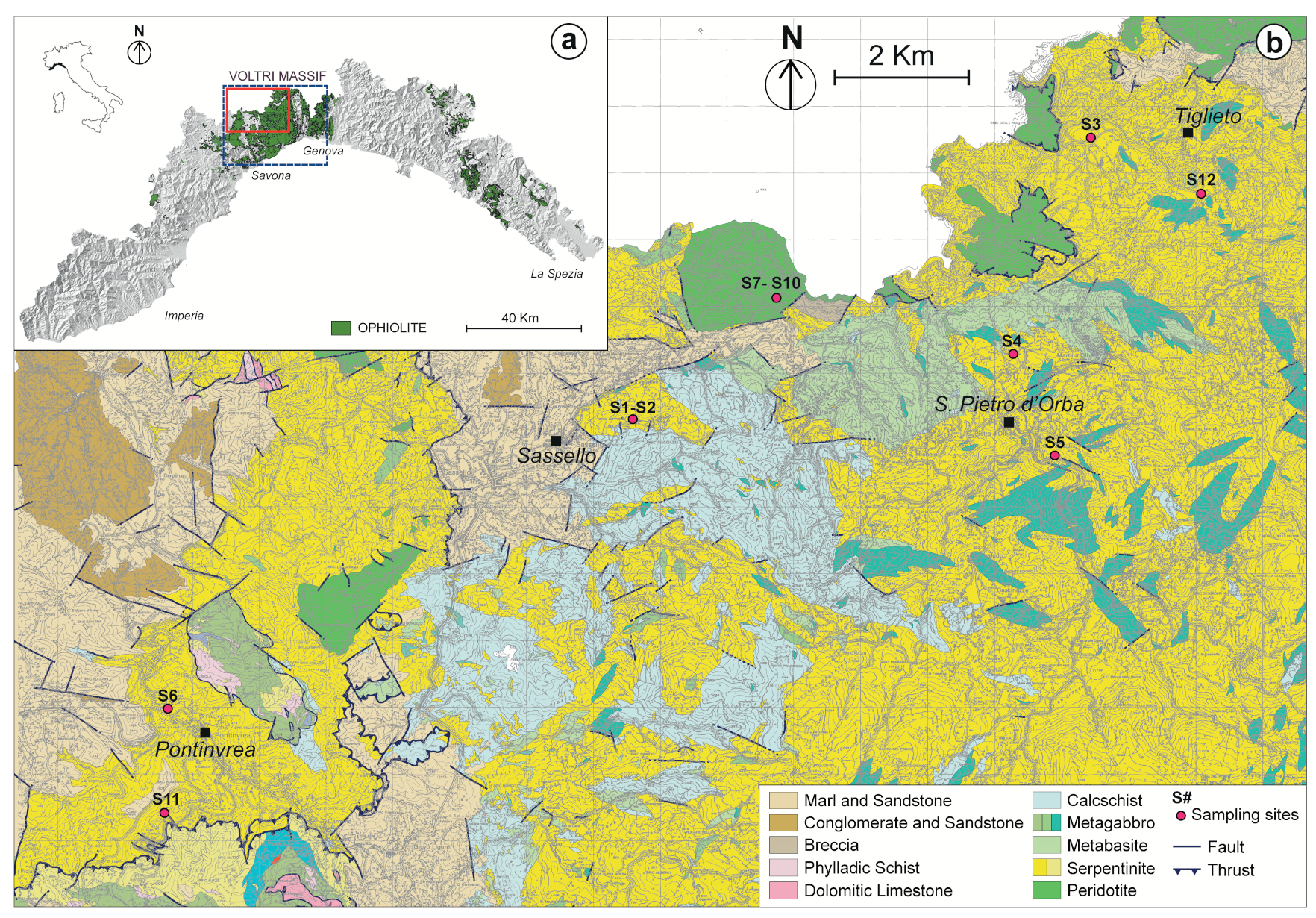
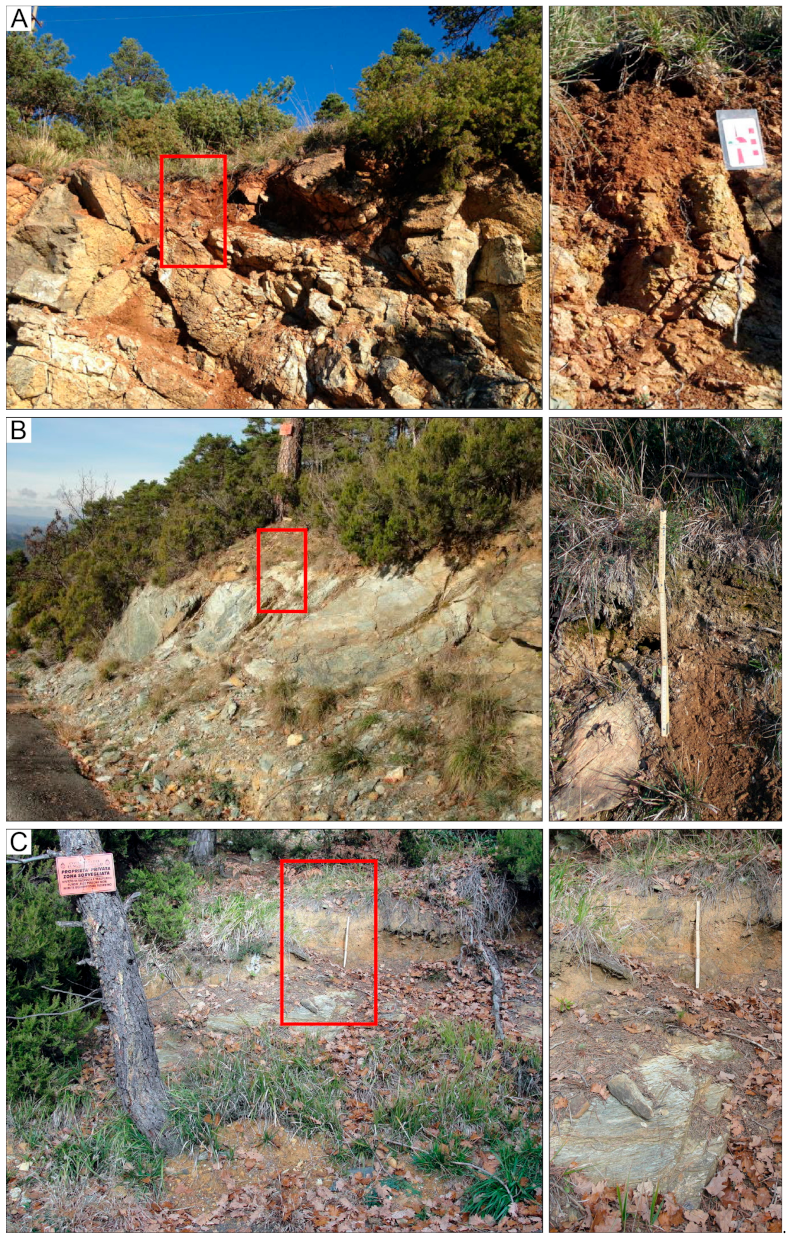
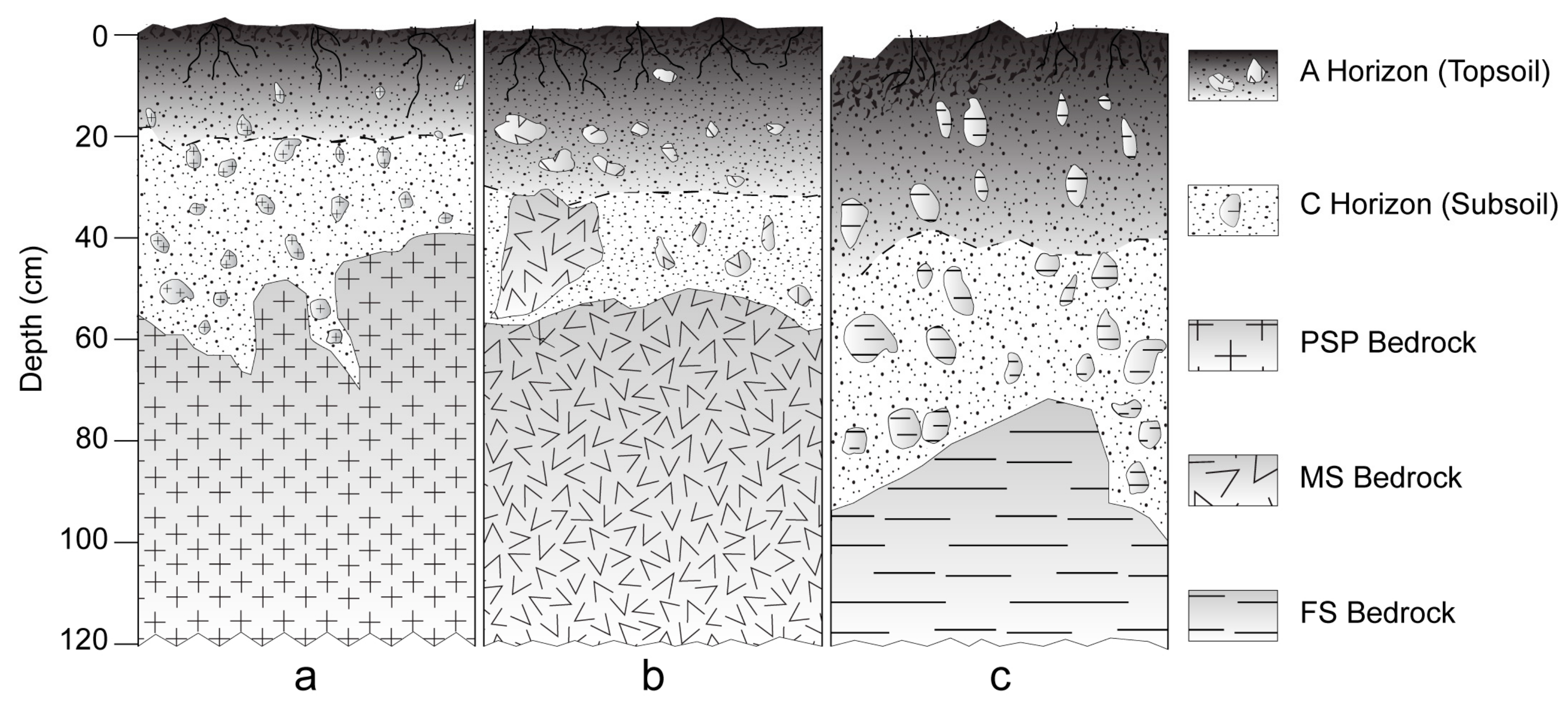
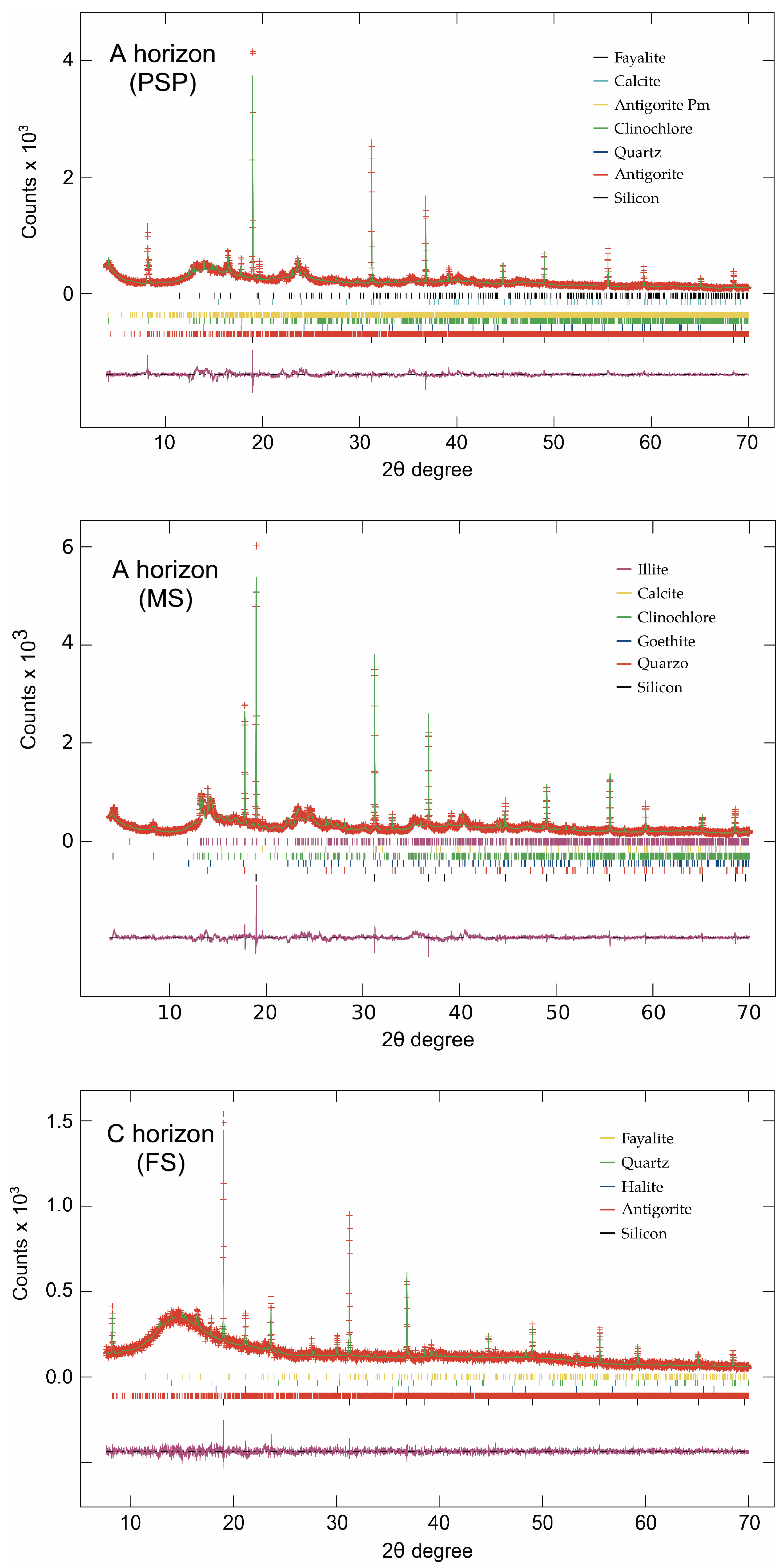
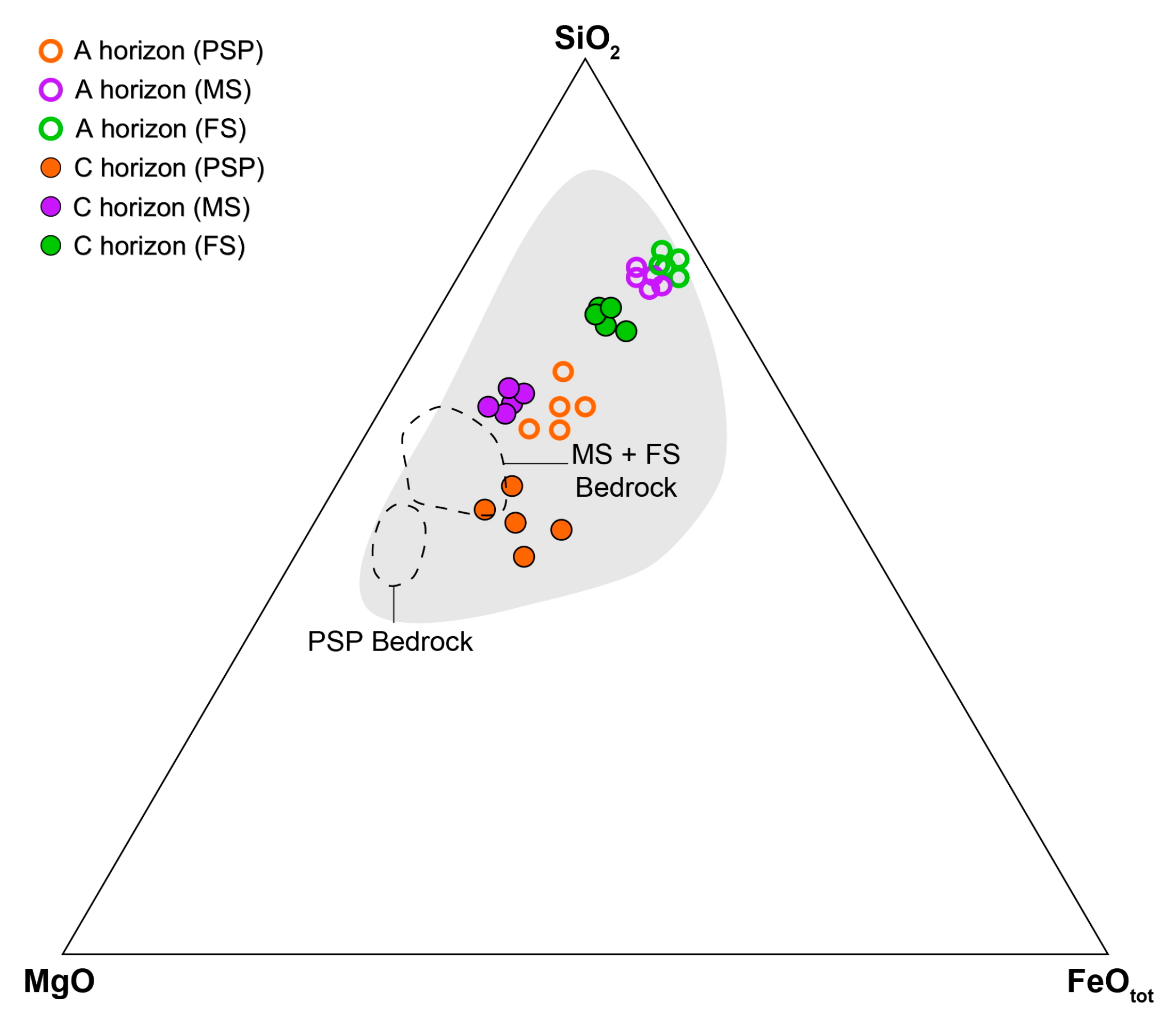
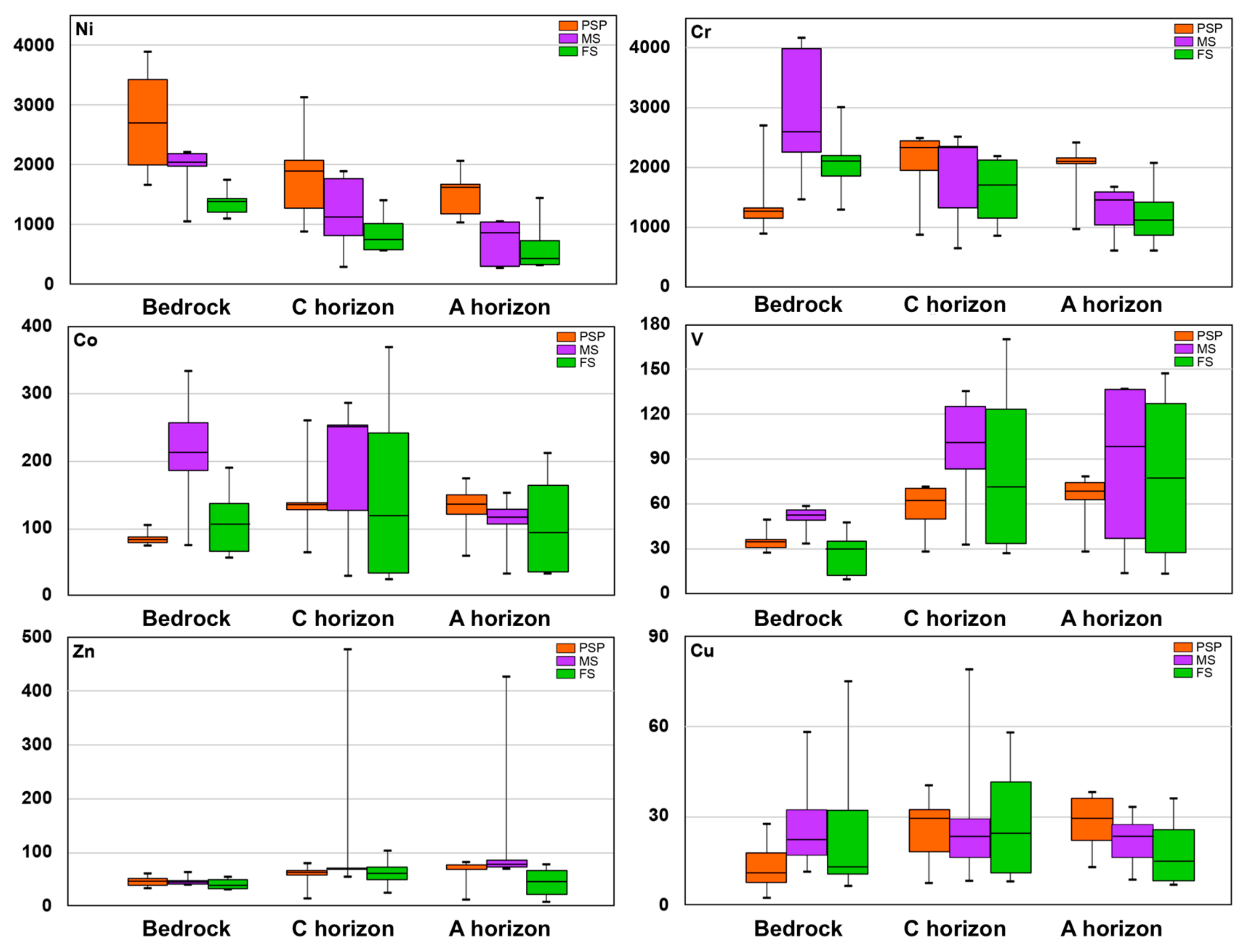
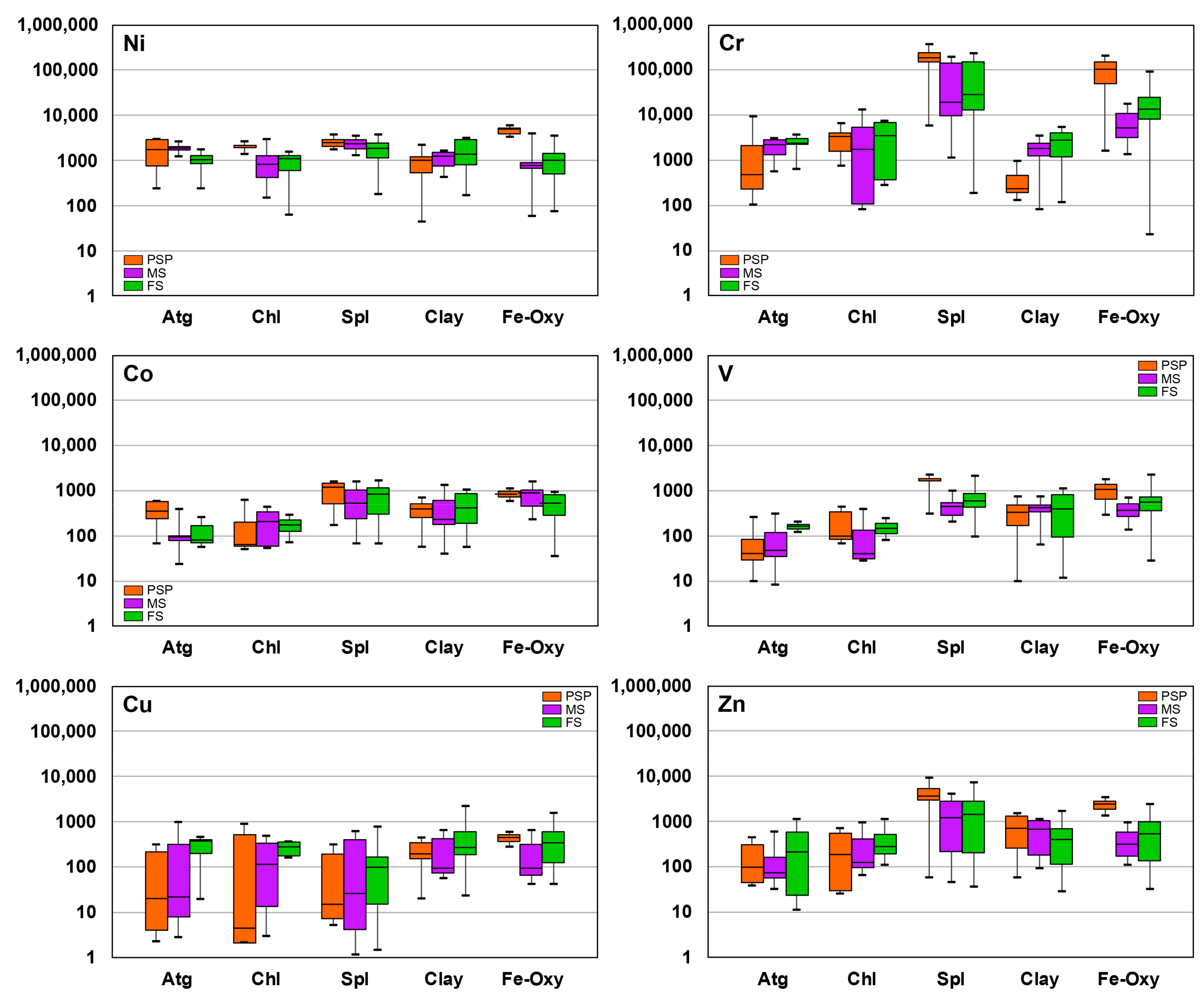

| Bedrock Type | PSP | MS | FS | |||
|---|---|---|---|---|---|---|
| A horizon | C horizon | A horizon | C horizon | A horizon | C horizon | |
| Antigorite | 43.1 | 48.1 | 52.1 | 56.4 | 50.8 | 57.2 |
| Clinochlore | 9.8 | 15.7 | 5.4 | 12.6 | 1.6 | 4.5 |
| Spinel-group minerals | 8.6 | 8.3 | 5.4 | 6.8 | 0.9 | 7 |
| Chrysotile | 2.2 | 2.1 | 2.7 | 2.9 | 0.9 | 2 |
| Enstatite | 8.3 | 9.1 | n.d. | n.d. | n.d. | n.d. |
| Goethite | 4.3 | 4.8 | n.d. | n.d. | 0.9 | 0.7 |
| Clay minerals | 2.8 | 0.8 | 2.7 | 2.2 | 8.7 | 5.2 |
| Amorphous | 20.9 | 11.2 | 31.9 | 19.1 | 36.2 | 23.3 |
| Accessory Minerals | Hem, Tr, Ol, Aug, Qtz, Cal | Hem, Tr, Ol, Aug, Pl, Qtz | Hem, Gt, Tr, Rt, Ilm, Hl, Qtz | Pl, Gt, Hem, Qtz | Tlc, Rt, Hem, Cal, Qtz | Tlc, Hem, Qtz |
| Primary minerals | 72 | 83.2 | 65.5 | 78.7 | 54.2 | 70.8 |
| Authigenic minerals | 28 | 16.8 | 34.5 | 21.3 | 45.8 | 29.2 |
| Refinement details | ||||||
| Rp | 0.071 | 0.073 | 0.071 | 0.079 | 0.086 | 0.087 |
| Rwp | 0.101 | 0.100 | 0.091 | 0.101 | 0.110 | 1.123 |
| Mineralogy of the clay fraction | ||||||
| Atg, Ol, Qtz, Chl* | Atg, Ol, Hem, Chl* | Atg, Qtz, Ol, Chl* | Atg, Chl*, Qtz, Mag | Chl*, Ill, Qtz | Chl*, Qtz, Ill | |
| Type | Data | MgO | Al2O3 | SiO2 | CaO | TiO2 | MnOt | FeOt | V | Cr | Co | Ni | Cu | Zn |
|---|---|---|---|---|---|---|---|---|---|---|---|---|---|---|
| Soils on PSP Bedrock | ||||||||||||||
| A horizon | Avg | 21.13 | 3.05 | 33.34 | 1.30 | 0.15 | 0.18 | 12.15 | 60 | 1940 | 130 | 1530 | 30 | 60 |
| M | 21.27 | 3.05 | 34.60 | 1.25 | 0.15 | 0.18 | 11.99 | 70 | 2100 | 130 | 1670 | 30 | 80 | |
| Min | 17.91 | 2.64 | 29.01 | 0.67 | 0.12 | 0.17 | 10.15 | 30 | 960 | 60 | 1040 | 10 | 10 | |
| Max | 23.91 | 3.47 | 35.15 | 2.04 | 0.20 | 0.19 | 14.47 | 70 | 2400 | 170 | 2050 | 40 | 80 | |
| C horizon | Avg | 22.64 | 2.66 | 32.71 | 1.06 | 0.12 | 0.20 | 14.65 | 60 | 2010 | 140 | 1850 | 20 | 50 |
| M | 23.63 | 2.83 | 32.82 | 1.24 | 0.13 | 0.17 | 14.33 | 60 | 2330 | 130 | 1880 | 30 | 60 | |
| Min | 18.07 | 1.71 | 30.82 | 0.17 | 0.05 | 0.16 | 11.31 | 30 | 870 | 60 | 890 | 10 | 10 | |
| Max | 25.38 | 3.26 | 34.37 | 1.60 | 0.15 | 0.30 | 18.63 | 70 | 2480 | 260 | 3130 | 40 | 80 | |
| Soils on MS Bedrock | ||||||||||||||
| A horizon | Avg | 20.84 | 7.71 | 53.04 | 1.14 | 0.76 | 0.19 | 9.87 | 80 | 1290 | 110 | 710 | 20 | 150 |
| M | 20.71 | 7.92 | 52.97 | 1.09 | 0.77 | 0.19 | 9.58 | 100 | 1460 | 110 | 860 | 20 | 80 | |
| Min | 15.90 | 6.24 | 51.14 | 0.97 | 0.69 | 0.16 | 9.53 | 10 | 620 | 30 | 270 | 10 | 70 | |
| Max | 26.03 | 8.75 | 55.07 | 1.41 | 0.83 | 0.22 | 10.79 | 140 | 1690 | 150 | 1050 | 30 | 430 | |
| C horizon | Avg | 21.41 | 7.14 | 50.82 | 0.87 | 0.70 | 0.22 | 9.88 | 90 | 1840 | 190 | 1180 | 30 | 150 |
| M | 21.41 | 6.99 | 49.82 | 0.88 | 0.71 | 0.22 | 9.85 | 100 | 2350 | 250 | 1140 | 20 | 70 | |
| Min | 14.30 | 6.79 | 48.23 | 0.46 | 0.32 | 0.22 | 9.27 | 30 | 660 | 30 | 290 | 10 | 50 | |
| Max | 28.52 | 7.79 | 55.42 | 1.27 | 1.04 | 0.22 | 10.54 | 130 | 2510 | 290 | 1890 | 80 | 480 | |
| Soils on FS Bedrock | ||||||||||||||
| A horizon | Avg | 16.58 | 9.46 | 54.53 | 1.28 | 0.92 | 0.25 | 10.87 | 80 | 1220 | 110 | 640 | 20 | 40 |
| M | 17.08 | 9.46 | 54.53 | 1.28 | 0.92 | 0.25 | 10.93 | 80 | 1100 | 90 | 420 | 10 | 40 | |
| Min | 12.89 | 8.35 | 50.46 | 1.02 | 0.69 | 0.23 | 10.46 | 10 | 610 | 30 | 300 | 10 | 10 | |
| Max | 19.27 | 10.57 | 58.59 | 1.53 | 1.15 | 0.27 | 11.17 | 150 | 2080 | 210 | 1430 | 40 | 80 | |
| C horizon | Avg | 19.80 | 8.82 | 50.90 | 1.18 | 1.08 | 0.34 | 14.05 | 90 | 1620 | 160 | 850 | 30 | 60 |
| M | 19.80 | 8.82 | 50.85 | 1.18 | 1.08 | 0.37 | 14.05 | 70 | 1700 | 120 | 720 | 20 | 60 | |
| Min | 18.27 | 6.99 | 50.49 | 0.53 | 0.66 | 0.20 | 11.03 | 30 | 860 | 20 | 560 | 10 | 20 | |
| Max | 21.34 | 10.64 | 51.40 | 1.83 | 1.50 | 0.44 | 17.08 | 170 | 2200 | 370 | 1390 | 60 | 100 | |
© 2019 by the authors. Licensee MDPI, Basel, Switzerland. This article is an open access article distributed under the terms and conditions of the Creative Commons Attribution (CC BY) license (http://creativecommons.org/licenses/by/4.0/).
Share and Cite
Marescotti, P.; Comodi, P.; Crispini, L.; Gigli, L.; Zucchini, A.; Fornasaro, S. Potentially Toxic Elements in Ultramafic Soils: A Study from Metamorphic Ophiolites of the Voltri Massif (Western Alps, Italy). Minerals 2019, 9, 502. https://doi.org/10.3390/min9080502
Marescotti P, Comodi P, Crispini L, Gigli L, Zucchini A, Fornasaro S. Potentially Toxic Elements in Ultramafic Soils: A Study from Metamorphic Ophiolites of the Voltri Massif (Western Alps, Italy). Minerals. 2019; 9(8):502. https://doi.org/10.3390/min9080502
Chicago/Turabian StyleMarescotti, Pietro, Paola Comodi, Laura Crispini, Lara Gigli, Azzurra Zucchini, and Silvia Fornasaro. 2019. "Potentially Toxic Elements in Ultramafic Soils: A Study from Metamorphic Ophiolites of the Voltri Massif (Western Alps, Italy)" Minerals 9, no. 8: 502. https://doi.org/10.3390/min9080502
APA StyleMarescotti, P., Comodi, P., Crispini, L., Gigli, L., Zucchini, A., & Fornasaro, S. (2019). Potentially Toxic Elements in Ultramafic Soils: A Study from Metamorphic Ophiolites of the Voltri Massif (Western Alps, Italy). Minerals, 9(8), 502. https://doi.org/10.3390/min9080502







